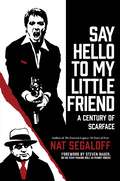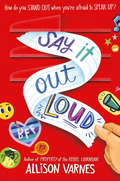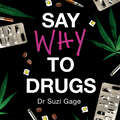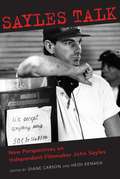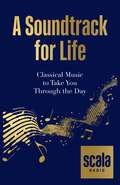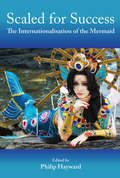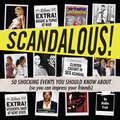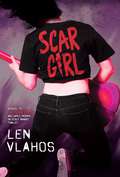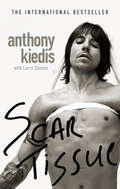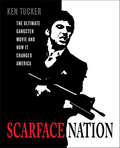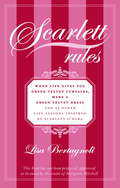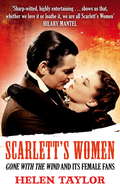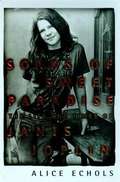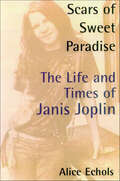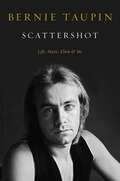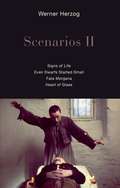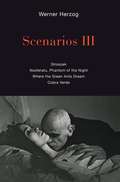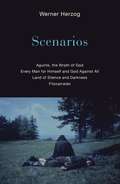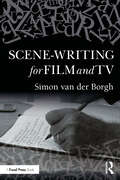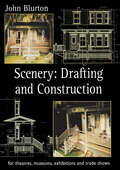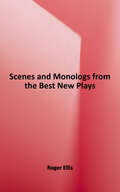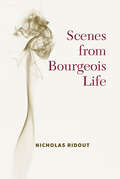- Table View
- List View
Say Hello to My Little Friend: A Century of Scarface
by Nat SegaloffThe author of The Exorcist Legacy: 50 Years of Fear, brings us another sensational Hollywood tell-all celebrating the 40th anniversary of Brian De Palma&’s legendary 1983 gangster film, while also showcasing its broader appeal across the past century by confronting the equally controversial legacy of its 1932 predecessor. When Brian DePalma&’s operatically violent Scarface debuted in 1983, the film drew almost as much fire as the relentless gunfire in the film itself. Starring Al Pacino as Cuban refugee-turned-crime-boss Tony Montana, Steven Bauer as his best friend Manny, and Michelle Pfeiffer as an Eighties gangster&’s moll, the movie revamped the original 1932 film for a new era of drugs, sex, and graphic violence. Attacked as both a celebration of cocaine-fueled excess and a condemnation of it, the film&’s reputation continued to rise over the years. But the real story of its success started nearly a century ago—when Hollywood first fell in love with the American gangster . . . Hollywood&’s infatuation with money, power, and organized crime has captured the public&’s imagination and made Scarface one of its most enduring modern myths. From a 1912 gangster film by D.W. Griffith to the 1932 hit Scarface starring Paul Muni, to Brian DePalma&’s 1983 shocker, the antihero&’s rise and fall exposes the dark side of the American Dream—whether it&’s Prohibition Era bootleggers or modern-day drug dealers. When actor Al Pacino got the idea of doing a remake of Scarface after screening the original, a legend was (re)born—and the rest is history. Filled with behind-the-scenes anecdotes, untold tales from Old and New Hollywood, and sixteen pages of eye-popping photos, Say Hello to My Little Friend is the ultimate guide to everything Scarface. With guns blazing and chainsaws whirring, movie biz writer Nat Segaloff tears into this pop culture phenomenon with fascinating insights, stunning revelations, and a true fan&’s glee. This is a must-have book for movie buffs, crime lovers, and culture vultures everywhere.
Say It Out Loud
by Allison VarnesAn empowering look at finding your voice, facing your fears, and standing up for what's right, from the author of Property of the Rebel Librarian. Charlotte Andrews is perfectly fine being quiet--in fact, she prefers it. When she doesn't speak, people can't make fun of her stutter. But when she witnesses bullying on the school bus and doesn't say anything, her silence comes between her and her best friend. <p><p> As if that wasn't bad enough, her parents signed her up for musical theater. Charlotte doesn't want to speak onstage, but at least she doesn't stutter when she sings. Then, just as she starts to find her voice, the arts program is cut. Charlotte can't stay silent anymore. <p><p> So she begins to write. Anonymous encouraging notes to her classmates. Letters to the school board to save the school musical. And an essay about the end of her best friendship--and her hope that she can still save it. <p><p> Words could save Charlotte Andrews and everything she believes in . . . if she just believes in herself enough to speak up.
Say Why to Drugs: Everything You Need to Know About the Drugs We Take and Why We Get High
by Dr Suzi GageA definitive and authoritative guide to drugs and why we get high from the creator of the top-rated podcast, Say Why to Drugs.Drugs. We've all done them. Whether it's a cup of coffee or a glass of wine, a cigarette or a sleeping pill. But how well do we understand the effects of the drugs we take - legal or illegal?Say Why to Drugs investigates the science behind recreational drugs- debunking common myths and misconceptions, as well as containing the most recent scientific research. Looking at a range of drugs, this book provides a clear understanding of how drugs work and what they're really doing to your mind and body. Along the way you will find out why ketamine is on the WHO's list of essential medicines, why some researchers hope MDMA could treat PTSD, and much more.Enlightening, entertaining, and thought-provoking, Say Why to Drugs is a compelling read that will surprise and educate proponents on both sides of the drugs debate.(P)2020 Hodder & Stoughton Limited
Sayles Talk: New Perspectives on Independent Filmmaker John Sayles
by Diane Carson Heidi KenagaHis name is synonymous with "independent film," and for more than twenty-five years, filmmaker John Sayles has tackled issues ranging from race and sexuality to the abuses of capitalism and American culture, aspiring to a type of realism that Hollywood can rarely portray. This collection offers unprecedented coverage of Sayles's craft and content, as it deploys a rich variety of critical methods to explore the full scope of his work. Together the essays afford a deeper understanding not only of the individual films--including his 1980 The Return of the Secaucus Seven (named to the National Registry) and the recent Limbo and Men with Guns--but also of Sayles's unusual place in American cinema and his influence worldwide. The focus of Sayles's films is frequently on peoples' lives, not on stories with tidy endings, and often a main goal is to alert viewers of their complicity in the problems at hand. One might assume his style to be content driven, but closer inspection reveals a mix of styles from documentary to postmodern. In this anthology, a set of international scholars addresses these and many other aspects of Sayles's filmmaking as they explore individual works. Their methodological approaches include historical and industry analysis as well as psychoanalysis and postcolonial theory, to name a few. Sayles Talk is both an in-depth and wide-ranging tribute to the "father" of independent film. In one volume, readers can find discussions of most of Sayles's films together with a comprehensive introduction to his film practice, an annotated list of existing literature on Sayles, and information on resources for further inquiry into his fiction, film, and television work. Film students as well as seasoned critics will turn to this book time and again to enrich their understanding of one of America's great cinematic innovators and his legacy.
Scala Radio's A Soundtrack for Life: Classical Music to Take You Through the Day
by Scala RadioBringing together much-loved masterpieces with exciting new works, this accessible and inspiring guide is a celebration of classical music. With pieces ranging from Vaughan Williams's The Lark Ascending and Beethoven's Pastoral Symphony to the scores for Avatar and Assassin's Creed, each entry puts the piece of music into context, providing fascinating insights into the inspirations behind each work and enhancing your listening experience. Organised into Occasions and Themes, the book features music to accompany you through your day, from getting up and getting dressed to running, reading, walking the dog, cooking, taking a bath, going to sleep and everything in between. You'll also find expert curations of the world's most romantic music and the greatest Christmas choral works as well as compositions that celebrate the natural world and mark births and marriages. Perfect for classical music enthusiasts as well as anyone looking for an enjoyable introduction to this genre, this is the definitive modern guide to classical music.
Scaled for Success: The Internationalisation of the Mermaid
by Philip HaywardEmerging from the confluence of Greco-Roman mythology and regional folklore, the mermaid has been an enduring motif in Western culture since the medieval period. It has also been disseminated more widely, initially through Western trade and colonisation and, more recently, through the increasing globalisation of media products and outlets. Scaled for Success offers the first detailed overview of the mermaids dispersal outside Europe. Complementing previous studies of the interrelationship between the mermaid and Mami Wata spirit in West Africa, this volume addresses the mermaids presence in a range of Middle Eastern, Asian, Australian, Latin American and North American contexts. Individual chapters identify the manner in which the mermaid has been variously syncretised and/or resignified in contexts as diverse as Indian public statuary, Thai cinema and Coney Islands annual Mermaid Parade. Rather than lingering as a relic of a bygone age, the mermaid emerges as a versatile, dynamic and, above all, polyvalent figure. Her prominence exemplifies the manner in which contemporary media-lore has extended the currency of established folkloric figures in new and often surprising ways. Analysing aspects of religious symbolism, visual art, literature and contemporary popular culture, this copiously illustrated volume profiles an intriguing and highly diverse phenomenon. Philip Hayward is editor of the journal Shima and holds adjunct professor positions at the University of Technology Sydney and at Southern Cross University. His previous volume, Making a Splash: Mermaids (and Mermen) in 20th and 21st Century Audiovisual Media, was published by John Libbey Publishing/Indiana University Press in 2017.
Scandalous!
by Hallie FrydDo you love a good scandal? This book includes 50 juicy pop culture, political, and entertainment-related scandals complete with photos, event synopses, and a look at why it went down in history and how it continues to influence us today. Other features include famous quotes and a section on where the players are now. Teens will get the dish on: Milli Vanilli's lip-syncing the Clinton-Lewinsky affair the Biggie and Tupac murders the Kent State shooting the OJ Simpson Murder trial Patty Hearst's kidnapping And more!
Scandalous!: 50 Shocking Events You Should Know About (So You Can Impress Your Friends)
by Hallie FrydDo you love a good scandal? This book includes 50 juicy pop culture, political, and entertainment-related scandals complete with photos, event synopses, and a look at why each one went down in history and how it continues to influence us today. Other features include famous quotes and a section on where the players are now. Teens will get the dish on: Milli Vanilli's lip-syncing the Clinton-Lewinsky affair the Biggie and Tupac murders the Kent State shooting the OJ Simpson Murder trial Patty Hearst's kidnapping And more!
Scar Girl
by Len VlahosWhen The Scar Boys ended, the band has fallen apart. Harry and Johnny are barely speaking, and Cheyenne is feeling desperate about Johnny, who has retreated into silence. It's only through their music that the group is able to rebuild their relationships, and they slowly begin to reach musical success and fame. In Scar Girl, Cheyenne, Harry, and Richie tell their own stories as they discover the ups and downs of being rock musicians—including meltdowns on stage, too much drinking, keeping secrets that should be shared, and having fights that test the limits of their friendship. The band's reputation grows and grows, but will the kids themselves survive? Len Vlahos delivers a powerful sequel to his bestselling YA sensation, The Scar Boys, with a story of love, music, and heartbreak.
Scar Tissue
by Anthony KiedisIn SCAR TISSUE Anthony Kiedis, charismatic and highly articulate frontman of the Red Hot Chili Peppers, recounts his remarkable life story, and the history of the band itself. Raised in the Midwest, he moved to LA aged eleven to live with his father Blackie, purveyor of pills, pot, and cocaine to the Hollywood elite. After a brief child-acting career, Kiedis dropped out of U.C.L.A. and plunged headfirst into the demimonde of the L.A. underground music scene. He formed the band with three schoolfriends - and found his life's purpose. Crisscrossing the country, the Chili Peppers were musical innovators and influenced a whole generation of musicians. But there's a price to pay for both success and excess and in SCAR TISSUE, Kiedis writes candidly of the overdose death of his soul mate and band mate, Hillel Slovak, and his own ongoing struggle with an addiction to drugs.SCAR TISSUE far transcends the typical rock biography, because Anthony Kiedis is anything but a typical rock star. It is instead a compelling story of dedication and debauchery, of intrigue and integrity, of recklessness and redemption.
Scarface Nation: The Ultimate Gangster Movie and How It Changed America
by Ken Tucker"Don't get high on your own supply."Brian de Palma's brash, bloody version of Scarface was trashed by critics when it came out twenty-five years ago and didn't do well at the box office, but has become a spectacular fan favorite and enduring pop culture classic since."Never underestimate the greed of the other guy."What makes millions of people obsess over this movie? Why has Al Pacino's Tony Montana become the drug kingpin whose pugnacity and philosophy are revered in boardrooms and bedrooms across America? Who were the people that made the movie, influencing hip-hop style and swagger to this day?"The world is yours."Scarface Nation is Ken Tucker's homage to all things Scarface—from the stars that acted in it to the influence it's had on all of us, from facts, figures and stories about the making of the movie to a witty and comprehensive look at Scarface's traces in today's pop and political culture."Say hello to my li'l fren!"You know you love the line. You know you've seen the movie more than once. Now dive into the ultimate book of Scarface—mounded as high as the pile of cocaine on Tony's desk with delicious details and stimulating observations."You know what capitalism is? F--- you!"
Scarlett O'Hara's Younger Sister
by Evelyn KeyesThis story of a movie star by the star herself is vulgar, very real, very innocent by turns, with her views on Fredric March, Artie Shaw, John Huston, Kirk Douglas, Mike Todd and many more.
Scarlett Rules: When Life Gives You Green Velvet Curtains, Make a Green Velvet Dress
by Lisa Bertagnoli"Some day I'm going to do and say everything I want to do and say, and if people don't like it I don't care. "-Scarlett O'Hara, from Gone with the Wind Ever since the publication of Margaret Mitchell's 1936 epic blockbuster, Gone with the Wind, Scarlett O' Hara has captivated millions with her wily ways, saucy attitude, irresistible charms-and legendary faults. Now, in Scarlett Rules, intrepid journalist Lisa Bertagnoli shares 24 life-enhancing lessons inspired by Tara's most beguiling resident. Rule 1: Pretty Is as Pretty Does-Not a conventional beauty, the literary Scarlett knew it took more than an attractive face to get noticed. Learn to put your best features forward. Rule 8: Keep Your Eyes on the Prize-Scarlett used determination and perseverance to survive and thrive. Unlock your abilities and go for the gold. Rule 15: Find Your Niche-A woman ahead of her time, Scarlett succeeded on her strengths. Discover your gift and shine! With each pearl of wisdom comes a Scarlett Lesson featuring savvy advice from life coaches, relationship gurus, and other experts. Full of wit and insight, this irresistible guide guarantees that, as God is your witness, you'll never be without gumption, poise, and individual style again!
Scarlett's Women: 'Gone With the Wind' and its Female Fans
by Helen TaylorOne of the most successful books ever published and the basis of one of the most popular and highly praised Hollywood films of all time, Gone With the Wind has entered world culture in a way that few other stories have. Seventy-five years on from the cinematic release of Gone with the Wind, Helen Taylor looks at the reasons why the book and film have had such an appeal, especially for women. Drawing on letters and questionnaires from female fans, she brings together material from southern history, literature, film and feminist theory and discusses the themes of the Civil War and issues of race. She has previously written Gender, Race and Region in the writings of Grace King, Ruth McEnery Stuart and Kate Chopin and The Daphne Du Maurier Companion.culture and the reasons why Gone With the Wind maintains a special place in female hearts. 'fascinating . . . an original original' Suzy Feay, Time Out
Scarlett's Women: 'Gone With the Wind' and its Female Fans
by Helen TaylorOne of the most successful books ever published and the basis of one of the most popular and highly praised Hollywood films of all time, Gone With the Wind has entered world culture in a way that few other stories have.Seventy-five years on from the cinematic release of Gone with the Wind, Helen Taylor looks at the reasons why the book and film have had such an appeal, especially for women. Drawing on letters and questionnaires from female fans, she brings together material from southern history, literature, film and feminist theory and discusses the themes of the Civil War and issues of race. She has previously written Gender, Race and Region in the writings of Grace King, Ruth McEnery Stuart and Kate Chopin and The Daphne Du Maurier Companion.
Scars of Sweet Paradise: The Life and Times of Janis Joplin
by Alice EcholsJanis Joplin was the skyrocket chick of the sixties, the woman who broke into the boys' club of rock and out of the stifling good-girl femininity of postwar America. With her incredible wall-of-sound vocals, Joplin was the voice of a generation.
Scars of Sweet Paradise: The Life and Times of Janis Joplin
by Alice EcholsJanis Joplin was the skyrocket chick of the sixties, the woman who broke into the boys' club of rock and out of the stifling good-girl femininity of postwar America. With her incredible wall-of-sound vocals, Joplin was the voice of a generation, and when she OD'd on heroin in October 1970, a generation's dreams crashed and burned with her. Alice Echols pushes past the legary Joplin-the red-hot mama of her own invention-as well as the familiar portrait of the screwed-up star victimized by the era she symbolized, to examine the roots of Joplin's muscianship and explore a generation's experiment with high-risk living and the terrible price it exacted.A deeply affecting biography of one of America's most brilliant and tormented stars, Scars of Sweet Paradise is also a vivid and incisive cultural history of an era that changed the world for us all.
Scattershot: Life, Music, Elton, and Me
by Bernie Taupin**NEW YORK TIMES BESTSELLER** An evocative, clear-eyed, and revealing memoir by Bernie Taupin, the lyrical master and long-time collaborator of Elton John&“I loved writing, I loved chronicling life and every moment I was cogent, sober, or blitzed, I was forever feeding off my surroundings, making copious notes as ammunition for future compositions. . . . The thing is good, bad, or indifferent I never stopped writing, it was as addictive as any drug.&” This is the memoir music fans have been waiting for. Half of one of the greatest creative partnerships in popular music, Bernie Taupin is the man who wrote the lyrics for Elton John, who conceived the ideas that spawned countless hits, and sold millions and millions of records. Together, they were a duo, a unit, an immovable object. Their extraordinary, half-century-and-counting creative relationship has been chronicled in biopics (like 2019's Rocketman) and even John's own autobiography, Me. But Taupin, a famously private person, has kept his own account of their adventures close to his chest, until now. Written with honesty and candor, Scattershot allows the reader to witness events unfolding from Taupin's singular perspective, sometimes front and center, sometimes from the edge, yet always described vibrantly, with an infectious energy that only a vivid songwriter's prose could offer. From his childhood in the East Midlands of England whose imagination was sparked and forever informed by the distinctly American mythopoetics of country music and cowboy culture, to the glittering, star-studded fishbowl of &’70s and &’80s Beverly Hills, Scattershot is simultaneously a Tom Jones-like picaresque journey across a landscape of unforgettable characters, as well as a striking, first-hand account of a creative era like no other and one man&’s experience at the core of it. An exciting, multi-decade whirlwind told in a non-linear yet grounded narrative, Scattershot whizzes around the world as we ride shotgun with Bernie on his extraordinary life. We visit Los Angeles with him and Elton on the cusp of global fame. We spend time with him in Australia almost in residency at an infamous rock 'n' roll hotel in an endless blizzard of drugs. And we spend late, late night hours with John Lennon, with Bob Marley, and hanging with Frank Sinatra. And beyond the world of popular music, we witness memorable encounters with writers like Graham Greene, painters like Andy Warhol and Salvador Dali, and scores of notable misfits, miscreants, eccentrics, and geniuses, known and unknown. Even if they're not famous in their own right, they are stars on the page, and we discover how they inspired the indelible lyrics to songs such as &“Tiny Dancer,&” &“Candle in the Wind,&” &“Bennie and The Jets,&” and so many more. Unique and utterly compelling, Scattershot will transport the reader across the decades and around the globe, along the way meeting some of the greatest creative minds of the 20th century, and into the vivid imaginings of one of music's most legendary lyricists.
Scenarios II: Signs of Life; Even Dwarfs Started Small; Fata Morgana; Heart of Glass
by Werner HerzogThe second in a series: the master filmmaker&’s prose scenarios for four of his notable filmsOn the first day of editing Fata Morgana, Werner Herzog recalls, his editor said: &“With this kind of material we have to pretend to invent cinema.&” And this, Herzog says, is what he tries to do every day. In this second volume of his scenarios, the peerless filmmaker&’s genius for invention is on clear display. Written in Herzog&’s signature fashion—more prose poem than screenplay, transcribing the vision unfolding before him as if in a dream—the four scenarios here (three never before translated into English) reveal an iconoclastic craftsman at the height of his powers.Along with his template for the film poem Fata Morgana (1971), this volume includes the scenarios for Herzog&’s first two feature films, Signs of Life (1968) and Even Dwarfs Started Small (1970), along with the hypnotic Heart of Glass (1976). In a brief introduction, Herzog describes the circumstances surrounding each scenario, inviting readers into the mysterious process whereby one man&’s vision becomes every viewer&’s waking dream.
Scenarios III: Stroszek; Nosferatu, Phantom of the Night; Where the Green Ants Dream; Cobra Verde
by Werner HerzogFor the first time in English, and in his signature prose poetry, the film scripts of four of Werner Herzog&’s early works &“Herzog doesn&’t write traditional scripts,&” Film International remarked of the master filmmaker&’s Scenarios I and II. &“Instead, he writes scenarios which are like a hybrid of film, fiction, and prose poetry.&”Continuing a series that Publishers Weekly pronounced &“compulsively readable . . . equal parts challenging and satisfying, infuriating and enlightening,&” Scenarios III presents, for the first time in English, the shape-shifting scripts for four of Werner Herzog&’s early films: Stroszek; Nosferatu, Phantom of the Night; Where the Green Ants Dream; and Cobra Verde. We can observe Herzog&’s working vision as each of these scenarios unfolds in a form often dramatically different from the film&’s final version—as, in his own words, Herzog works himself up into &“this kind of frenzy of high-caliber language and concepts and beauty.&”With Scenarios I and II, this volume completes the picture of Herzog&’s earliest work, affording a view of the filmmaker mastering his craft, well on his way to becoming one of the most original, and most celebrated, artists in his field.
Scenarios: Aguirre, the Wrath of God; Every Man for Himself and God Against All; Land of Silence and Darkness; Fitzcarraldo
by Werner HerzogI do not follow ideas, I stumble into stories or into people; and I know that this is so big, I have to make a film. Very often, films come like uninvited guests, like burglars in the middle of the night. They are in your kitchen; something is stirring, you wake up at 3 a.m. and all of a sudden they come wildly swinging at you.When I write a screenplay, I write it as if I have the whole film in front of my eyes. Then it is very easy for me, and I can write very, very fast. It is almost like copying. But of course sometimes I push myself; I read myself into a frenzy of poetry, reading Chinese poets of the eighth and ninth century, reading old Icelandic poetry, reading some of the finest German poets like Hölderlin. All of this has absolutely nothing to do with the idea of my film, but I work myself up into this kind of frenzy of high-caliber language and concepts and beauty.And then sometimes I push myself by playing music, for example, a piano concerto by Beethoven, and I play it and write furiously. But none of this is an answer to the question of how you focus on a single idea for a film. And then, during shooting, you have to depart from it sometimes, while keeping it alive in its essence. —Werner Herzog, on filmmakingWerner Herzog doesn&’t write traditional screenplays. He writes fever dreams brimming with madness, greed, humor, and dark isolation that can shift dramatically during production—and have materialized into extraordinary masterpieces unlike anything in film today. Harnessing his vision and transcendent reality, these four pieces of long-form prose earmark a renowned filmmaker at the dawn of his career.
Scene-writing for Film and TV
by Simon van der BorghFocusing on an integral aspect of screenplays, this book takes students and writers at all levels through the process of understanding and writing better scenes. It interrogates the functions of a scene and how writers can then apply this knowledge to their own film and television scripts. Author Simon van der Borgh familiarises the screenwriter with the fundamental aspects of a scene, looking at what a scene is, the characters involved, the action depicted, dialogue, setting, and style. Featuring original scenes which show the practice of scene-writing and the application of ideas and approaches alongside in-depth analysis and critique, the book explores the process and approach to scene-writing and how to learn and improve methods of telling dynamic, engaging and moving stories of diverse types and formats on screen. With a strong focus on practice-based advice, the book includes exercises at every step to enable writers to build on and extend their knowledge and skills with confidence and clarity chapter by chapter. Exploring the film and TV scene with its different types, forms, and functions, it is the ideal book for aspiring screenwriters and students of screenwriting and filmmaking at all levels, as well as directors, producers and actors looking to better understand the contextual and sub-textual motivations intended by the writer.
Scenery: Draughting and Construction for Theatres, Museums, Exhibitions and Trade Shows
by John BlurtonThis practical book looks at the types of drawing used, equipment, materials commonly specified, surveying, and also covers building floors, flats, cloths, windows, doors, trucks, staircases, roofs, revolves, multi-story structures, and bridges. By addressing both theater and the commercial world this book will be of real help to a broad range of people in the theater industry.
Scenes and Monologs from the Best New Plays: An Anthology of New Dramatic Writing from Professionally Produced American Plays
by Roger EllisThis book is a practical resource for acting and directing students of all ages middle through high school, college, and professionals young and old. Its 30 duet scenes and eight monologues include a fair sampling of the late 20th-century work of playwrights across the United States. These excerpts are highly original in that few people can claim to have read or seen them performed, though they have all been produced regionally. The gallery of characters contained in these pages offers readers an arresting and kaleidoscopic reflection of American society. The literary styles one encounters here demonstrate the range and power of American writers who will continue to shape theatrical techniques for years to come. Overall, this anthology provides a generous sampling of vital and compelling treatments of our social, artistic, and spiritual experiences of the late 20th century.
Scenes from Bourgeois Life (Theater: Theory/Text/Performance)
by Nicholas RidoutScenes from Bourgeois Life proposes that theatre spectatorship has made a significant contribution to the historical development of a distinctive bourgeois sensibility, characterized by the cultivation of distance. In Nicholas Ridout’s formulation, this distance is produced and maintained at two different scales. First is the distance of the colonial relation, not just in miles between Jamaica and London, but also the social, economic, and psychological distances involved in that relation. The second is the distance of spectatorship, not only of the modern theatregoer as consumer, but the larger and pervasive disposition to observe, comment, and sit in judgment, which becomes characteristic of the bourgeois relation to the rest of the world. This engagingly written study of history, class, and spectatorship offers compelling proof of “why theater matters,” and demonstrates the importance of examining the question historically.
